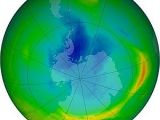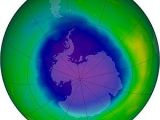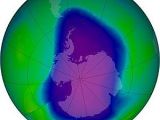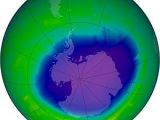Earth's ozone layer is the shield against excessive amounts of ultraviolet radiation coming from the Sun, and measurements over the past thirty years show that over the Antarctic and the Arctic, the holes in the ozone are constantly evolving.
The damage to the ozone layer was caused by well-intentioned chemicals like chlorofluorocarbons, which were used for refrigerants and aerosol spray-cans.
So when the governments around the world woke up and saw the destruction in the late 1980s, they negotiated the Montreal Protocol, an international treaty meant to eliminate ozone-depleting chemicals.
Among the treaty's requirements, there is the regularly assessment and report of the state of the ozone layer, especially of the annual Antarctic ozone hole.
The images below show the evolution of the ozone hole above the Antarctic, on the day of its maximum depletion (the days with the thinnest ozone layer, measured in Dobson Units – DU), in four different years.
The purple and dark blue areas are part of the ozone hole.
The first time that ozone was measured by satellite, on September 17, 1979 (the first image), the ozone level was at 194 DU.
Ten years later, on October 7, 1989 (second image), and the same year that the Montreal Protocol went into force, the ozone dropped to 108 DU.
Then, on October 9, 2006, the ozone measured 82 DU, and by October 1, 2010, the value was back up to 118 DU.
The deepest hole ever recorded was 73 DU, on September 30, 1994, while the widest one spread across 29.9 million square kilometers, and was recorded on September 29, 2000.
The science advisers to the Montreal Protocol, found in their 2010 report that global ozone and ozone in the Arctic and Antarctic is no longer decreasing, nor is it increasing yet.
Outside the Polar Regions, the ozone layer should recover to the levels prior to 1980, before 2050, since this recovery could be sped up by the greenhouse gas-induced cooling of the upper stratosphere.
As for the ozone hole over the Antarctic, it is expected to recover much later, but until then, its impact can be seen in surface temperature and wind patterns.
Over the last decade, the surface ultraviolet radiation level has been constant at mid-latitudes.
The Ozone Secretariat of the United Nations Environment Program, released its latest report in January 2011, which concluded that the Protocol has “protected the stratospheric ozone layer from much higher levels of depletion...[and] provided substantial co-benefits by reducing climate change.”
From 1979 to 2003, these measurements were made by NASA’s Total Ozone Mapping Spectrometer (TOMS) instruments and from 2004 to the present day, they were made by the Royal Netherlands Meteorological Institute (KNMI) Ozone Monitoring Instrument (OMI).
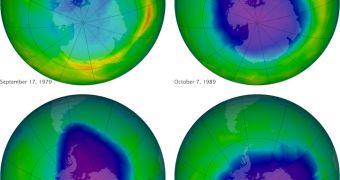
 14 DAY TRIAL //
14 DAY TRIAL // 
